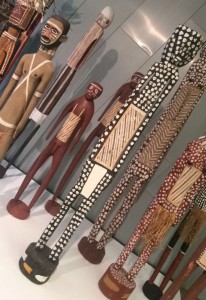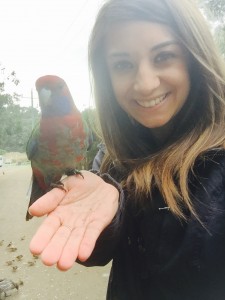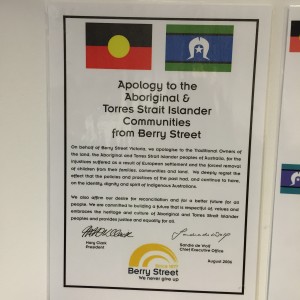Now that my trip to Australia has come to an end and I am back in the states, I realize just how much I learned from the agencies while there. I have been excited to share the knowledge I gained about the Aboriginal culture and the child welfare system and children’s metal health with others as I tell them about my experience abroad. One area that impacted my learning the most was discovering the history and culture of the Aboriginal people. Before this trip, my knowledge about this population of people was extremely limited, but thanks to the women at VACCA, I feel like I have a greater understanding of the struggles they have gone through throughout the course of history in addition to realizing that there are many struggles they still face today.
to Australia has come to an end and I am back in the states, I realize just how much I learned from the agencies while there. I have been excited to share the knowledge I gained about the Aboriginal culture and the child welfare system and children’s metal health with others as I tell them about my experience abroad. One area that impacted my learning the most was discovering the history and culture of the Aboriginal people. Before this trip, my knowledge about this population of people was extremely limited, but thanks to the women at VACCA, I feel like I have a greater understanding of the struggles they have gone through throughout the course of history in addition to realizing that there are many struggles they still face today.
The Aboriginal population is the oldest civilization in the world, and yet they, like so many other indigenous groups worldwide, were targeted and slaughtered when the Europeans arrived and wanted to colonize Australia. There was no recognition of the hundreds of tribes who lived and thrived across Australia and most importantly considered this great cou ntry to be there home. Similar to the Native Americans in the United States, the Aboriginals’ weaponry was no match for the English and they also became victims of smallpox that the Europeans unknowingly brought with them. Unfortunately, the hardships of this group of people do not end here. The many different Aboriginal communities, languages, and values were not respected and instead they were discriminated against and the communities were disbanded by the government. The government also implemented a policy for the removal of Aboriginal children from their families in what became known as the Stolen Generations. The women at VACCA shared personal stories about how their own family members had been personally impacted by this horrible movement. What shocked and outraged me even more was that the official apology for the Stolen Generations was not issued by the Australia government until 2008.
ntry to be there home. Similar to the Native Americans in the United States, the Aboriginals’ weaponry was no match for the English and they also became victims of smallpox that the Europeans unknowingly brought with them. Unfortunately, the hardships of this group of people do not end here. The many different Aboriginal communities, languages, and values were not respected and instead they were discriminated against and the communities were disbanded by the government. The government also implemented a policy for the removal of Aboriginal children from their families in what became known as the Stolen Generations. The women at VACCA shared personal stories about how their own family members had been personally impacted by this horrible movement. What shocked and outraged me even more was that the official apology for the Stolen Generations was not issued by the Australia government until 2008.
Despite the horrors the Aboriginal population has faced throughout history and the discrimination they still face today in the form of conviction rates, disproportionate drug and alcohol statistics, and the widespread racism throughout the country, this group of people has shown great resiliency and determination to rise above all the negativity and honor their ancestors and culture. Today, land and spirituality are still very important to the Aboriginal people. 35% own their own homes and more than 70% of students in grades 7 through 10 are attending school. While there is a long way to go in regards to Aboriginal’s civil rights, they have come a long way as a population since the English arrived in 1788.
Visiting VA CCA first and learning about the Aboriginal history and culture allowed me to recognize and appreciate the other agencies we visited acknowledging this group of people by flying the Aboriginal flag and giving recognition to the land along with the elders and ancestors. It made me realize that many of the social service agencies are pushing for true equality for this group of people which I found to be really valuable.
CCA first and learning about the Aboriginal history and culture allowed me to recognize and appreciate the other agencies we visited acknowledging this group of people by flying the Aboriginal flag and giving recognition to the land along with the elders and ancestors. It made me realize that many of the social service agencies are pushing for true equality for this group of people which I found to be really valuable.
In addition to the Aboriginal culture, our time at the various agencies also taught me a lot about the child welfare in Victoria and throughout all of Australia. Overall, I found the child welfare system is Australia to be similar to that in the U.S. One of the main differences, however, is that Australia uses the title “foster carer” instead of “foster parent” like the U.S. does. This was representative to their reluctance to “replace” the parent with another caregiver. Many studies show that separation from their family can be detrimental to a child’s wellbeing. The U.S. tends to place a strong emphasis on reunification with parents, both because of this research and also because there is a shortage of foster parents. It seemed like Australia emphasized keeping the families together even more and that the laws in place to remove children were slightly different. That is not to say they would not remove a child if the situation warrants it, but by calling the new caregivers foster carers, they are creating an atmosphere in which the parent is not giving up their title and therefore are not as hurt and angry over the situation, thereby allowing more possibilities for the parents to have the motivation to get the help they need in order to care for themselves and their children.
Unfortunately, one similarity Australia’s child welfare system shares with the U.S. is that at 18, the children age out of the system. This leaves many children on their own with no resources or support to live independently and be a contributing member to society. Multiple organizations we visited are working towards addressing this issue. Lighthouse targets homeless young people between the ages of 16 and 22 in order to give them a loving, safe home and the support they need to succeed on their own. Anglicare is the largest foster care agency in Victoria, and they also mentioned how they are in the process of developing programs to help with the negative impacts aging out of the system has on many young people.
Since I have my undergraduate degree in psychology and am specializing in mental health, I was especially interested to learn how approaches children’s mental health and how it differed from the U.S. The most notable difference is that Australia has universal health care which makes mental health services more widely available to children and families than it is in the United States. While more expensive, private agencies do exist, many mental health agencies in Australia are publicly funded by the government and therefore free for the consumer. I think this approach opens up many more opportunities for individuals and families to be able to access the mental health services they need. In the U.S. there is not only a shortage of available services, but they are also incredibly expensive and often difficult to get covered by medical insurance.
I am not saying that Australia’s system is perfect, however. When we visited the Bouvarie Centre, we learned about the many different methods they were using to help families in Australia address and treat their mental illnesses. Despite the high quality of this organization and the many people they have been able to give mental health services to, the waiting list is always longer. Like in the U.S., Australia seems to have a greater need for mental health care than there are services provided. While more funding and an increase in the number of mental health organizations is needed to help address this issue, I still feel like they are doing a much better job than the U.S. at making mental health care accessible to everyone.
My experience in Australia was absolutely amazing. Not only did I learn about the child welfare and mental health systems here, I also had the opportunity to explore a new place and learn about a new culture. I enjoyed seeing the vario us sites in Melbourne and loved even more seeing the penguins on Phillip’s Island and exploring the scenery and wildlife along the Great Ocean Road. The memories and relationships, both personal and professional, that I am taking away with me are invaluable to my life moving forward, both personally and in my education and future career as a social worker. Learning about child welfare and children’s mental health in Australia has inspired me to not only keep learning about these areas in other cultures, but to complete more research in them in my own. While I am still eager to begin my career working as a clinical social worker focusing on children’s mental health, I am also more interested in investigating mental health policies in the U.S. and using other countries, like Australia, as an influence to implement a positive change.
us sites in Melbourne and loved even more seeing the penguins on Phillip’s Island and exploring the scenery and wildlife along the Great Ocean Road. The memories and relationships, both personal and professional, that I am taking away with me are invaluable to my life moving forward, both personally and in my education and future career as a social worker. Learning about child welfare and children’s mental health in Australia has inspired me to not only keep learning about these areas in other cultures, but to complete more research in them in my own. While I am still eager to begin my career working as a clinical social worker focusing on children’s mental health, I am also more interested in investigating mental health policies in the U.S. and using other countries, like Australia, as an influence to implement a positive change.



 dangerous dessert. I had this idea that Australia would be so absolutely different from the United States. Sure, Australians drive and walk on the opposite side of the road and every living creature there could kill you, but on a day-to-day basis it really was not that different. Just like in Columbus, the people of Australia wake up every morning and go to work, use their selfie sticks, love their football and cannot escape road construction for the life of them.
dangerous dessert. I had this idea that Australia would be so absolutely different from the United States. Sure, Australians drive and walk on the opposite side of the road and every living creature there could kill you, but on a day-to-day basis it really was not that different. Just like in Columbus, the people of Australia wake up every morning and go to work, use their selfie sticks, love their football and cannot escape road construction for the life of them.
 s program has given me a newfound respect for the field. It is one thing to learn about social work in the classroom but it is truly a completely different thing to watch it happen in front of you in real-world situations. The added culture value was a pure bonus!
s program has given me a newfound respect for the field. It is one thing to learn about social work in the classroom but it is truly a completely different thing to watch it happen in front of you in real-world situations. The added culture value was a pure bonus!














